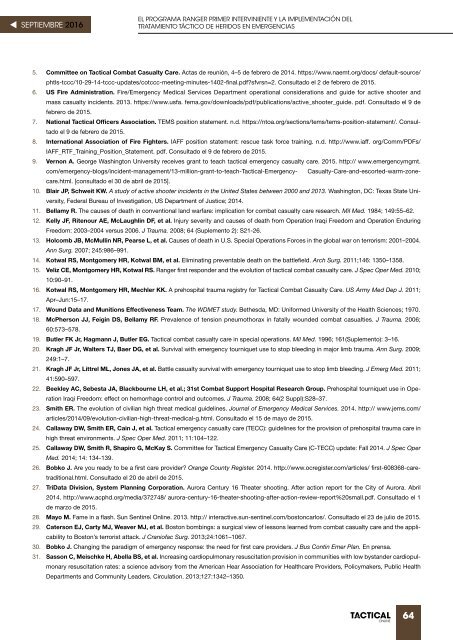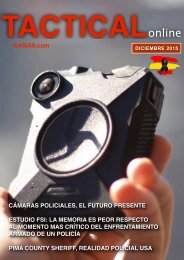SEPTIEMBRE
09_TO_2016_SEP
09_TO_2016_SEP
Create successful ePaper yourself
Turn your PDF publications into a flip-book with our unique Google optimized e-Paper software.
<strong>SEPTIEMBRE</strong> 2016<br />
EL PROGRAMA RANGER PRIMER INTERVINIENTE Y LA IMPLEMENTACIÓN DEL<br />
TRATAMIENTO TÁCTICO DE HERIDOS EN EMERGENCIAS<br />
5. Committee on Tactical Combat Casualty Care. Actas de reunión, 4–5 de febrero de 2014. https://www.naemt.org/docs/ default-source/<br />
phtls-tccc/10-29-14-tccc-updates/cotccc-meeting-minutes-1402-final.pdf?sfvrsn=2. Consultado el 2 de febrero de 2015.<br />
6. US Fire Administration. Fire/Emergency Medical Services Department operational considerations and guide for active shooter and<br />
mass casualty incidents. 2013. https://www.usfa. fema.gov/downloads/pdf/publications/active_shooter_guide. pdf. Consultado el 9 de<br />
febrero de 2015.<br />
7. National Tactical Officers Association. TEMS position statement. n.d. https://ntoa.org/sections/tems/tems-position-statement/. Consultado<br />
el 9 de febrero de 2015.<br />
8. International Association of Fire Fighters. IAFF position statement: rescue task force training. n.d. http://www.iaff. org/Comm/PDFs/<br />
IAFF_RTF_Training_Position_Statement. pdf. Consultado el 9 de febrero de 2015.<br />
9. Vernon A. George Washington University receives grant to teach tactical emergency casualty care. 2015. http:// www.emergencymgmt.<br />
com/emergency-blogs/incident-management/13-million-grant-to-teach-Tactical-Emergency- Casualty-Care-and-escorted-warm-zonecare.html.<br />
[consultado el 30 de abril de 2015].<br />
10. Blair JP, Schweit KW. A study of active shooter incidents in the United States between 2000 and 2013. Washington, DC: Texas State University,<br />
Federal Bureau of Investigation, US Department of Justice; 2014.<br />
11. Bellamy R. The causes of death in conventional land warfare: implication for combat casualty care research. Mil Med. 1984; 149:55–62.<br />
12. Kelly JF, Ritenour AE, McLaughlin DF, et al. Injury severity and causes of death from Operation Iraqi Freedom and Operation Enduring<br />
Freedom: 2003–2004 versus 2006. J Trauma. 2008; 64 (Suplemento 2): S21-26.<br />
13. Holcomb JB, McMullin NR, Pearse L, et al. Causes of death in U.S. Special Operations Forces in the global war on terrorism: 2001–2004.<br />
Ann Surg. 2007; 245:986–991.<br />
14. Kotwal RS, Montgomery HR, Kotwal BM, et al. Eliminating preventable death on the battlefield. Arch Surg. 2011;146: 1350–1358.<br />
15. Veliz CE, Montgomery HR, Kotwal RS. Ranger first responder and the evolution of tactical combat casualty care. J Spec Oper Med. 2010;<br />
10:90–91.<br />
16. Kotwal RS, Montgomery HR, Mechler KK. A prehospital trauma registry for Tactical Combat Casualty Care. US Army Med Dep J. 2011;<br />
Apr–Jun:15–17.<br />
17. Wound Data and Munitions Effectiveness Team. The WDMET study. Bethesda, MD: Uniformed University of the Health Sciences; 1970.<br />
18. McPherson JJ, Feigin DS, Bellamy RF. Prevalence of tension pneumothorax in fatally wounded combat casualties. J Trauma. 2006;<br />
60:573–578.<br />
19. Butler FK Jr, Hagmann J, Butler EG. Tactical combat casualty care in special operations. Mil Med. 1996; 161(Suplemento): 3–16.<br />
20. Kragh JF Jr, Walters TJ, Baer DG, et al. Survival with emergency tourniquet use to stop bleeding in major limb trauma. Ann Surg. 2009;<br />
249:1–7.<br />
21. Kragh JF Jr, Littrel ML, Jones JA, et al. Battle casualty survival with emergency tourniquet use to stop limb bleeding. J Emerg Med. 2011;<br />
41:590–597.<br />
22. Beekley AC, Sebesta JA, Blackbourne LH, et al.; 31st Combat Support Hospital Research Group. Prehospital tourniquet use in Operation<br />
Iraqi Freedom: effect on hemorrhage control and outcomes. J Trauma. 2008; 64(2 Suppl):S28–37.<br />
23. Smith ER. The evolution of civilian high threat medical guidelines. Journal of Emergency Medical Services. 2014. http:// www.jems.com/<br />
articles/2014/09/evolution-civilian-high-threat-medical-g.html. Consultado el 15 de mayo de 2015.<br />
24. Callaway DW, Smith ER, Cain J, et al. Tactical emergency casualty care (TECC): guidelines for the provision of prehospital trauma care in<br />
high threat environments. J Spec Oper Med. 2011; 11:104–122.<br />
25. Callaway DW, Smith R, Shapiro G, McKay S. Committee for Tactical Emergency Casualty Care (C-TECC) update: Fall 2014. J Spec Oper<br />
Med. 2014; 14: 134-139.<br />
26. Bobko J. Are you ready to be a first care provider? Orange County Register. 2014. http://www.ocregister.com/articles/ first-608368-caretraditional.html.<br />
Consultado el 20 de abril de 2015.<br />
27. TriData Division, System Planning Corporation. Aurora Century 16 Theater shooting. After action report for the City of Aurora. Abril<br />
2014. http://www.acphd.org/media/372748/ aurora-century-16-theater-shooting-after-action-review-report%20small.pdf. Consultado el 1<br />
de marzo de 2015.<br />
28. Mayo M. Fame in a flash. Sun Sentinel Online. 2013. http:// interactive.sun-sentinel.com/bostoncarlos/. Consultado el 23 de julio de 2015.<br />
29. Caterson EJ, Carty MJ, Weaver MJ, et al. Boston bombings: a surgical view of lessons learned from combat casualty care and the applicability<br />
to Boston’s terrorist attack. J Craniofac Surg. 2013;24:1061–1067.<br />
30. Bobko J. Changing the paradigm of emergency response: the need for first care providers. J Bus Contin Emer Plan. En prensa.<br />
31. Sasson C, Meischke H, Abella BS, et al. Increasing cardiopulmonary resuscitation provision in communities with low bystander cardiopulmonary<br />
resuscitation rates: a science advisory from the American Hear Association for Healthcare Providers, Policymakers, Public Health<br />
Departments and Community Leaders. Circulation. 2013;127:1342–1350.<br />
ONLINE<br />
64




